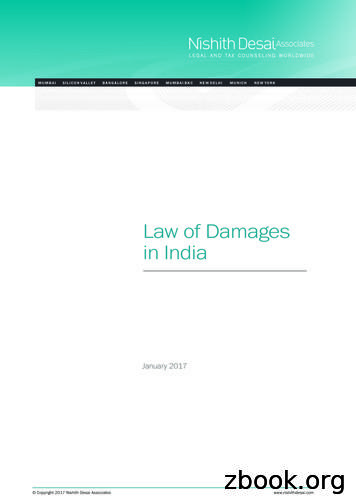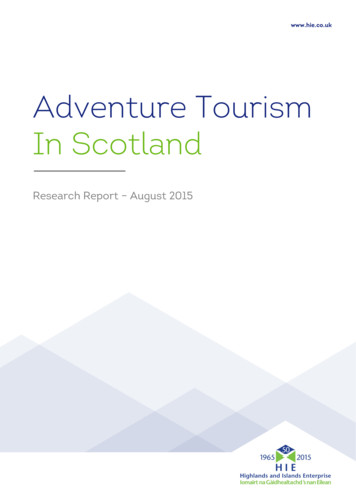Tribal Natural Resource Damages, Assessment And .
Tribal Natural Resource Damages,Assessment and RestorationConferenceStratus ConsultingKaylene Ritter, PhDJuly 20, 2011STRATUS CONSULTINGSTRATUSCONSULTING
NRDA Overview and DefinitionsSTRATUS CONSULTINGSTRATUSCONSULTING
NRDA – Overview Purpose: Make the public whole for injuries tonatural resources that result from the releaseof hazardous substances or oil The public is made whole through“restoration” (damages recovered must beused for restoration)STRATUS CONSULTING
NRDA – Overview (cont.) Includes compensation for harms that mayaccrue over time: past, present, future NRDA restoration complements, but isdistinct from, response “cleanup” actionsSTRATUS CONSULTING
NRDA – Definitions Damages: Amount of money sought by a trusteeas compensation for injured natural resourcesand service losses (must be used for restoration) Injury: Measurable adverse change in qualityor viability of a natural resource resulting fromexposure to a release of a hazardoussubstance or discharge of oilSTRATUS CONSULTING
NRDA – Definitions (cont.) Services: Physical, biological, human andcultural functions performed by the naturalresource Examples of physical and biological services: Habitat Foraging FoodSTRATUS CONSULTING
NRDA – Definitions (cont.) Examples of cultural services from naturalresources:– Direct use of the resources Food, crafts, commerce– Transmission of language skills to youth– Ceremonial– Historic meeting sites Societal interchangeSTRATUS CONSULTING
Service LossSTRATUS CONSULTINGSTRATUSCONSULTING
Service LossReleaseNo Action — Natural RecoveryTimeSTRATUS CONSULTING
Service Loss (cont.)ReleaseNo Action — Natural RecoveryTimeSTRATUS CONSULTING
Service Loss (cont.)NRDA Restoration (Primary)InterimLossNo Action — Natural RecoveryTimeSTRATUS CONSULTING
Service Loss (cont.)NRDA RestorationInterim Loss if no primary restorationNo Action — Natural RecoveryTimeSTRATUS CONSULTING
NRDA and RI/FSSTRATUS CONSULTINGSTRATUSCONSULTING
Fundamentally Different Processeswith Different Objectives RI/FS: Inform response/remedial actions– Goal manage risks to human health andthe environment NRDA: Process of determining the effects ofreleases of chemicals/oil on natural resources– Goal make the public whole for injuriesto natural resources through restorationSTRATUS CONSULTING
NRDA vs. RI/FS Temporal focus– RI/FS: current and future residualconditions– NRDA: past/present/futureSTRATUS CONSULTING
NRDA vs. RI/FS Spatial focus– RI/FS: where hazardous substances havecome to be located. Actions focused onsite (source/risk reduction)– NRDA: where exposure/injury/servicelosses may have occurred. Restorationalternative evaluation can be broader,including off-siteSTRATUS CONSULTING
Key Questions for TrusteesSTRATUS CONSULTINGSTRATUSCONSULTING
Key Questions for NRDA Trustees What can be done to restore resources andservices to baseline?– Taking into account remedial actions If resources and services cannot be restoredto baseline, what is appropriatecompensation? What additional restoration is necessary toaddress past losses?STRATUS CONSULTING
Key Questions Specific to TribalTrustees Are there specific tribal uses and losses thatcan be addressed through restorationprojects?– Cultural / ceremonial– Recreational– Subsistence– Commercial How can restoration projects be designed tospecifically provide those uses and benefits?STRATUS CONSULTING
NRDA ProcessSTRATUS CONSULTINGSTRATUSCONSULTING
Administrative Process (DOI) Preassessment Screen Assessment Plan Assessment Phase– Injury determination– Injury quantification– Damage determination– Restoration planning– Restoration and Compensation Determination Plan(RCDP) Report of Assessment Post Assessment Phase– Restoration Plan– Implementation of restorationSTRATUS CONSULTING
Injury DeterminationSTRATUS CONSULTINGSTRATUSCONSULTING
Injury Determination Determine:– Source(s) and release(s) of hazardoussubstance(s)– Environmental exposure (direct/indirect)via pathways– Injuries to trust natural resourcesSTRATUS CONSULTING
Injury Determination: Sources andReleases Characterize hazardous substance releases– Which hazardous substance(s)?– Timing/frequency/duration?– Location?– Quantity?– Responsible party?STRATUS CONSULTING
Injury Determination: PathwaySources of Hazardous SubstancesGroundwaterSediment(bed, bank, and floodplain)Surface WaterBenthicMacroinvertebratesInjured FishSTRATUS CONSULTING
Injury Determination: Examples Surface water and groundwater– Contaminant concentrations that exceedregulatory limits– Conditions sufficient to adversely affect Biological resources Human/cultural usesSTRATUS CONSULTING
Injury Determination: Examples (cont.) Soils (“geologic resources”)– Chemical concentrations toxic tomicroorganisms, invertebrates, plants,wildlife– Reduced water-holding capacity, nutrientcyclingSTRATUS CONSULTING
Injury Determination: Examples (cont.) Vegetation– Reduced cover,diversity, health, vigor,reproductive capacity,stabilitySTRATUS CONSULTING
Injury Determination: Examples (cont.) Habitats– Alterations in habitat structure, resistance,resilience, stabilitySTRATUS CONSULTING
Injury Determination: Examples (cont.) ndocrine ochemicalchangesSTRATUS CONSULTINGGenetic effectsDisease
Injury QuantificationSTRATUS CONSULTINGSTRATUSCONSULTING
Injury Quantification Quantify changes relative to baseline– Extent or degree of injury– Percent occurrence in individual,population, community– Magnitude of effects Temporal extent Spatial extentSTRATUS CONSULTING
Injury Quantification Example:GroundwaterSTRATUS CONSULTING
Injury Quantification Example:Groundwater (cont.)STRATUS CONSULTING
Tribal NRDA Claims Tribal claims likely to include lost cultural useof natural resources that are above andbeyond ecological impactsSTRATUS CONSULTING
Tribal NRDA Claims (cont.) Injury quantification can be difficult, culturaluse of natural resources is not commonlymeasured– Cultural uses typically not formally tracked– Information may be sensitive E.g., use and location of importantspeciesSTRATUS CONSULTING
Tribal NRDA Claims (cont.) Focus on restoration projects with tribal usebenefits that can address the losses thathave occurred– Cultural / ceremonial– Recreational– Subsistence– CommercialSTRATUS CONSULTING
SummaryReleasePathwayRestorationPrimary and CompensatorySTRATUS CONSULTINGInjuryServiceLossDamages
STRATUS CONSULTINGSTRATUSCONSULTING
Extra SlidesSTRATUS CONSULTING
NRDA vs. RI/FS (cont.) Characterization– RI/FS: characterizesources/pathways/risks at level of detailnecessary to select appropriate remedialalternatives– NRDA: characterizeexposure/injury/service loss at level ofdetail necessary to determine and quantifylossesSTRATUS CONSULTING
Injury Determination: Pathway Sampling approach– Use environmental data to demonstratepresence of hazardous substances inpathway components Modeling approach– Use model to demonstrate environmentalmobility/transformationSTRATUS CONSULTING
Tribal Natural Resource Damages, Assessment and Restoration Conference Stratus Consulting Kaylene Ritter, PhD July 20, 2011. STRATUSSTRATUS CONSULTINGCONSULTING . – Restoration planning – Restoration and Compensation Determination Plan (RCDP) Report of Assessment Post Assessment Phase – Restoration Plan
IV. Aggravated and exemplary damages 02 V. Liquidated and unliquidated damages 03 3. THE LAW OF DAMAGES UNDER INDIAN CONTRACT ACT 1872 04 I. Breach of contract 05 II. Proof of damage for a claim of liquidated damages 05 III. Causation 07 IV. Remoteness of Damages 08 V. Mitigation 10 VI. Measure and calculation of damages 11 VII.
POWERS V. STANLEY BLACK & DECKER INC. (SDNY 2015) Court sides with SB&D: ‒ Under NY law, there are two general types of damages available for breach of contract: (1) general or market damages and (2) special or consequential damages. _ ‒ Diminution in value damages are general damages; waiver of damages in the Purchase
7.1 5.1 Damages-Proof 7.2 5.2 Measures of Types of Damages 7.3 5.3 Damages-Mitigation 7.4 5.4 Damages Arising in the Future-Discount to Present Cash Value 7.5 5.5 Punitive Damages 7.6 5.6 Nominal Damages 8.1 6.1 Preliminary Jury Instruction for Federal Employers' Liability Act (45 U.S.C. §§ 51 and 53) 8.2 6.2 FELA-Elements and .
Expanded Jobsite Overhead Acceleration Consequential Damages - Types of Damages Suffered by an Owner Defective and/or Incomplete Work Delays/Liquidated Damages Damages Concepts Regarding Specific Causes of Action - Breach of Contract - Negligence - Other Damages Concepts. 2
Tribal Chair, Robert Pino, Srt . Pauma Band of Luiseño Indians Tribal Chair, Temet A. Aguilar Iipay Nation of Santa Ysabel Tribal Chair, Virgil Perez Rincon Band of Luiseño Indians Tribal Chair, Bo Mazzetti Inaja-Cosmit Band of Indians Tribal Chair, Rebecca M. Osuna San Pasqual Band of Mi
Brahmavar. Results have reported as frequency and proportion. Independent t test was used to compare the self-esteem of tribal and non-tribal student. Study' found that more than two third of the tribal student had low self-esteem. There was statistically significant difference (p 0.01) in self-esteem between tribal and non-tribal students.
1.5 Overview of Natural Resource Damage Assessment Process . 4 . 1.6 Assessment Activities at the Site . 7. 1.7 Public Participation . 11 . 1.8 Organization of the Natural Resource Damage Assessment Plan . 11 . NATURAL RESOURCES AND RESOURCE SERVICES . 2.1 Description of the Study Area . 12. 2.2 Description and Definition of Natural Resources . 13
2 Adventure Tourism in Scotland – what do we mean? Introduction 2.1 This chapter details the definition of Adventure Tourism (AT) used by the study team for this commission and any assumptions which were made throughout the research. Definition of Adventure Tourism 2.2 The definition of the AT sector used for this study is the now commonly held sector definition developed in the Adventure .






















